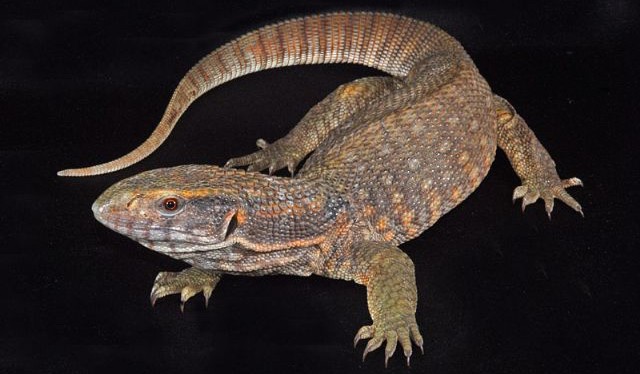Savannah Monitor (Varanus exanthematicus)
Natural history
Savannah monitors in the pet trade are either wild-caught or captive-raised.
[/ezcol_2third_end]
Taxonomy
Class: Reptilia
Order: Squamata
Family: Varanidae– monitors
Color and size
Savannah monitors are tan to gray with a lighter pattern on the back, sides, and anterior tail.
Adult size can be quite variable. Some individuals reach 2.5 ft (0.8 m) while others exceed 4.5 ft (1.4 m) and can even reach 6 ft (1.8 m) or more.
Diet
Much controversy surrounds the feeding of Savannah and other grassland monitors in captivity, and clients often bring questions about appropriate foods for their pet.
- The Savannah monitor is a carnivore. Offer gut-loaded insects such as large crickets, superworms, king mealworms, silkworms, grasshoppers, cockroaches, as well as crayfish and other low-fat foods like cooked egg whites or Egg beaters®. Mice or rats may be offered, but only occasionally to reduce the risk of obesity.
- Dust the non-breeding adult’s diet with a calcium carbonate or calcium gluconate supplement once weekly. Calcium supplements should be devoid or low in phosphorus with a minimum Ca:P ratio of 2:1. Avoid products containing Vitamin D as this can lead to toxicity. A general vitamin/mineral supplement may also be offered once weekly.
- Adults may be fed two to three times weekly.
- For more information, download the client handout: Feeding Insect Eating Reptiles.
Husbandry
Lifespan
5-10+ years
Anatomy/ physiology
| Dermatologic: | Unlike snakes, lizards normally exhibit a patchy shed or “ecdysis”. |
| Fat stores: | Fat pads are present with the caudoventral coelom. |
| Urogenital: | Monitors possess a thin-walled bladder. |
| Sexual dimorphism: | Adult males are larger and more robust with prominent femoral pores and a hemipenal bulge. The hemipenis is the copulatory organ of the male. The hemipenis will appear as radiodense opacities in some individuals. Femoral pores are the opening through which glands produce a thick, waxy secretion. This secretion plays a role in scent marking and other pheromone-based communication. |
Savannahs are the most mild mannered of the monitors, however all monitor lizards are capable of delivering a painful bite. Monitors also have strong talons.
Venipuncture
Ventral tail (coccygeal) vein
Ventral abdominal vein
Preventive medicine
Regular physical examination
Fecal parasite testing
Important medical conditions
- Coelomic neoplasia
- Egg yolk coelomitis
- Hepatic lipidosis
- Nutritional secondary hyperparathyroidism or metabolic bone disease (Download the client handout: Metabolic Bone Disease in Reptiles and Amphibians ).
- Obesity (rodent-based diet)
- Starvation (poor husbandry, parasitism, cold temperatures, under-feeding)
**Login to view references**
References
References
Bartlett RD, Bartlett PP. Monitors and Tegus, 2nd ed. Barron’s Educ Ser. 2006.
Bartlett RD, Bartlett P, and Griswold B. Reptiles, Amphibians, and Invertebrates: An Identification and Care Guide, 2nd ed. Hauppage, NY: Barron’s Educational Series; 2010.
De Vosjoli P. The Lizard Keeper’s Handbook. 2007, 2nd ed. Adv Viv Sys, Vista CA.
Weber N. Savannah monitor lizard (Varanus exanthematicus) and white-throated monitor lizard (Varanus albigularis albigularis). Exotic DVM 10(4):24-25, 2008.
Pollock C. Basic information sheet: Savannah monitor. June 26, 2012. LafeberVet Web site. Available at https://lafeber.com/vet/basic-information-for-savannah-monitor/
